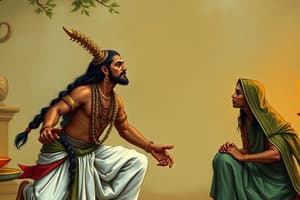Podcast
Questions and Answers
What is the approximate time period when Kalidasa wrote the play Shakuntala?
What is the approximate time period when Kalidasa wrote the play Shakuntala?
- 6th century CE
- 2nd century CE
- 4th or 5th century CE (correct)
- 8th century CE
Which Hindu epic is the story of Shakuntala based on?
Which Hindu epic is the story of Shakuntala based on?
- Ramayana
- Vedas
- Mahabharata (correct)
- Puranas
What is the characteristic of Kalidasa's use of language in the play?
What is the characteristic of Kalidasa's use of language in the play?
- Simple and direct
- Complex and ambiguous
- Lyricism, imagery, and poetic beauty (correct)
- Formal and rigid
What is the significance of Shakuntala in Indian literature?
What is the significance of Shakuntala in Indian literature?
How many acts does the play Shakuntala consist of?
How many acts does the play Shakuntala consist of?
What is the style of the play characterized by?
What is the style of the play characterized by?
What has been the impact of Shakuntala on Indian culture?
What has been the impact of Shakuntala on Indian culture?
What is the theme of the play that explores the conflict between desire and responsibility?
What is the theme of the play that explores the conflict between desire and responsibility?
What is the significance of Shakuntala in Indian literature, in terms of its translation?
What is the significance of Shakuntala in Indian literature, in terms of its translation?
What is the character of Shakuntala in the play?
What is the character of Shakuntala in the play?
Flashcards
What is Shakuntala?
What is Shakuntala?
A Sanskrit play written by Kalidasa, a renowned Indian poet, around the 4th or 5th century CE.
What is the story of Shakuntala based on?
What is the story of Shakuntala based on?
The Mahabharata, a major Hindu epic, serves as the source material for the story. It tells the tale of King Dushyanta and Shakuntala, a young woman with divine origins.
What are the main themes of Shakuntala?
What are the main themes of Shakuntala?
Love, duty, and the struggles that arise when personal desires clash with responsibilities are central themes explored in the play.
How is Shakuntala structured?
How is Shakuntala structured?
Signup and view all the flashcards
What is notable about Kalidasa's language in Shakuntala?
What is notable about Kalidasa's language in Shakuntala?
Signup and view all the flashcards
What is Shakuntala's significance to Indian literature?
What is Shakuntala's significance to Indian literature?
Signup and view all the flashcards
How has Shakuntala spread globally?
How has Shakuntala spread globally?
Signup and view all the flashcards
What makes Shakuntala a timeless classic?
What makes Shakuntala a timeless classic?
Signup and view all the flashcards
How has Shakuntala impacted Indian culture?
How has Shakuntala impacted Indian culture?
Signup and view all the flashcards
What is the lasting impact of Shakuntala?
What is the lasting impact of Shakuntala?
Signup and view all the flashcards
Study Notes
Shakuntala: Kalidasa's Play and Indian Literature
Overview
- Shakuntala is a Sanskrit play written by the ancient Indian poet Kalidasa in the 4th or 5th century CE.
- It is considered one of the greatest works of Indian literature and a masterpiece of Sanskrit drama.
The Play
- The play is based on a story from the Mahabharata, a Hindu epic.
- It tells the story of King Dushyanta and Shakuntala, the daughter of a sage and a celestial nymph.
- The play explores themes of love, duty, and the conflict between desire and responsibility.
Structure and Style
- The play is divided into seven acts, with a mix of prose and verse.
- Kalidasa's use of language is known for its lyricism, imagery, and poetic beauty.
- The play's style is characterized by its use of metaphors, allegories, and symbolism.
Significance in Indian Literature
- Shakuntala is considered one of the greatest works of Indian literature, influencing Indian drama and poetry for centuries.
- It is one of the most translated and adapted Indian works, with translations in many languages, including German, French, and English.
- The play's exploration of themes and emotions has made it a timeless classic, continuing to inspire artists, writers, and scholars.
Impact on Indian Culture
- Shakuntala has had a profound impact on Indian culture, influencing art, music, and dance.
- The play's themes and characters have inspired countless works of art, literature, and performance.
- Shakuntala remains an important part of Indian cultural heritage, continuing to be studied, performed, and admired to this day.
Shakuntala: Kalidasa's Play and Indian Literature
Overview
- Written by Kalidasa in the 4th or 5th century CE
- Considered one of the greatest works of Indian literature and a masterpiece of Sanskrit drama
The Play
- Based on a story from the Mahabharata, a Hindu epic
- Tells the story of King Dushyanta and Shakuntala, the daughter of a sage and a celestial nymph
- Explores themes of love, duty, and the conflict between desire and responsibility
Structure and Style
- Divided into seven acts, with a mix of prose and verse
- Kalidasa's use of language is known for its lyricism, imagery, and poetic beauty
- Characterized by the use of metaphors, allegories, and symbolism
Significance in Indian Literature
- Considered one of the greatest works of Indian literature, influencing Indian drama and poetry for centuries
- One of the most translated and adapted Indian works, with translations in many languages
- Timeless classic, continuing to inspire artists, writers, and scholars
Impact on Indian Culture
- Profound impact on Indian culture, influencing art, music, and dance
- Themes and characters have inspired countless works of art, literature, and performance
- Remains an important part of Indian cultural heritage, continuing to be studied, performed, and admired
Studying That Suits You
Use AI to generate personalized quizzes and flashcards to suit your learning preferences.




